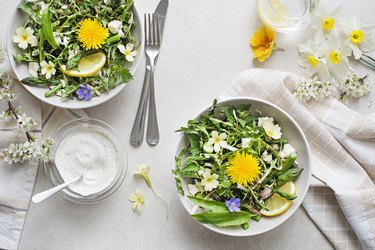
Things You'll Need
Trowel or shovel
Knife and cutting board or food processor
Large cooking pot (either non-metal or stainless steel)
Spring water
Cheesecloth
Vodka or vegetable glycerin
Dark 2 oz. or larger glass bottle with lid
Dandelion, the plant commonly labeled a weed and often ruthlessly expunged from yards, actually offers remarkable healing properties. The herbal healing tradition holds that dandelion powerfully cleanses the liver and blood, helps dissolve stones in the liver and gallbladder and aids in lowering cholesterol and blood pressure. Those seeking more than traditional healing can look to modern science for evidence. You'll find that dandelion root tea is indeed a diuretic, and is effective for treating yeast infection as well as ailments of the bladder, gallbladder, kidney and liver.
The roots of dandelion contain a very concentrated form of these healing powers. Making your own dandelion root tincture allows you to create an inexpensive health tonic to keep on hand year-round.
Video of the Day
Step 1: Locate the Plants for Making Dandelion Root Tincture
Choose the right location and time for collecting dandelion roots. The healing benefits of plant roots are strongest in the fall, after the flowers are gone but before the first frost. Many gardeners with an interest in herbal healing grow dandelions as part of an herb garden. If you have not already started cultivating dandelions, look for plants in healthy soil. Avoid roadside growth, which harbors unhealthy substances from vehicle exhaust and roadway maintenance chemicals..
Step 2: Collect the Dandelion Roots
Collect the dandelion roots. Using a trowel or small shovel, dig up the roots of the plant, being careful not to sever them. Place the roots in a covered basket or paper bag. You will want at least 4 oz. of root material to make your extract.
Step 3: Clean the Plants
Clean your plant material. Separate the roots from the rest of the plant, and remove any dirt, stones or insects.
Step 4: Chop the Roots
Chop the roots into pieces of about 1/4 inch using either a knife and cutting board or a food processor.
Step 5: Cook and Strain
Process the roots on a stove to extract all the water-soluble material. Place 4 oz. of dandelion roots in 2 qt. of water and bring to a boil. Let the pot simmer until you have reduced the liquid to about one quart, then strain through a cheesecloth. Reserve the liquid.
Add the roots to 1 qt. of water and again bring to a boil and reduce to 1 pt. Again, strain and save the liquid. Discard the boiled roots. Combine the liquid saved from the two boilings and reheat. Cook this down to about 2 oz. You will need to allow several hours for this process.
Step 6: Preserve the Dandelion Extract
Preserve the dandelion extract. After permitting the boiled down extract to cool, funnel it into a dark glass bottle with a lid or stopper. Add either vegetable glycerin or vodka as a preservative so the organic matter does not spoil.
Tip
You can also benefit from dandelion's healing benefits in other ways. Save some of the chopped root material, spread it on a pan, and roast in in the oven. Use roasted dandelion root to make a very strong tea, sometimes called dandelion coffee for its thick, dark, bitter taste. Drink this with milk and honey for a liver healing variation on cappuccino. Also, in summer, add dandelion greens to your favorite salad recipe.
Well-known today as a useful diuretic, the dandelion's French name, pissenlit, literally means "wet the bed".
Warning
Remember that the extract is a very concentrated form of healing, do not take in large doses. Take just a few drops a day either on your tongue or added to a tea. If you have a dandelion allergy, do not take dandelion extract.
Video of the Day